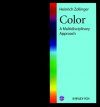![Color: A Multidisciplinary Approach Color: A Multidisciplinary Approach]()
Click to have a closer look
About this book
Contents
Related titles
About this book
Who is not attracted, fascinated or even amazed by the world of colors? First of all there are the painters of course, but also biologists and mineralogists are interested in colors of the living and the inorganic, 'dead', world. There are neuroscientists, psychologists and ophthalmologists, who study the sensation of color vision and the processing of color stimuli in the eye and the brain. Physicists and chemists investigate color science, i.e. the various causes of color. Interior designers know how the colors of furniture and textiles can influence our condition. In all cultures, colors play a central role due to their symbolic content. All Languages have special terms to describe colors and colorfulness. Visual artists play with colors to reflect the world, perhaps to alienate it, and to give us an idea of their personal point of view. Many other examples of the influence of colors on our daily life, our culture could be found... The 'exact' science cannot understand color phenomena. This really fascinating book, written in a style that is understandable for an interested layman, deals with all the varied facets of this subject.
Contents
Preface Contents INTRODUCTION What do we Mean by Color? Historical Survey PHYSICS OF LIGHT AND COLOR The Nature (Theory) of Light Color by Refraction: Newton's Experiments Color of the Rainbow Peacock's Colors, a Phenomenon of Interference How Many Causes of Color do we Know? CHEMISTRY OF COLOR History of Colorants Inorganic Pigments Organic Colorants Correlations between Chemical Structure and Color of Chemical Compounds COLORIMETRY Color Measurements Color - Harmony or Contrasts? HOW DO WE SEE COLORS Perception and Cognition of Color Anatomy of the Human Eye Photochemistry of the Retina What does the Eye tell the Brain? Psychophysical Investigations on Color Vision Color Vision of Animals HOW DO WE NAME COLORS? From Color Chemistry to Color Linguistics The Phenomenon (Prodigy) of Human Language Categorization of the Color Space by Color Naming Color and Phonological Universals Cultural Influence on Color Naming COLOR IN ART AND IN OTHER CULTURAL ACTIVITIES Color in European Art from Antiquity to Gothic From Renaissance to Neo-Impressionism Art in the 20th Century Color in the Art of Non-European Culture: The Case of Japan Color in Psychology Goethe's 'Farbenlehre' Sound-Color Synesthesia Epilogue Acknowledgements Author Index Subject Index.
Customer Reviews



































